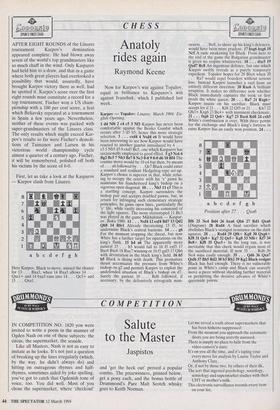i400 1 ioi - Dclatmaal SPAIN'S FINEST CAVA gpEt iagn agl
CHESS
SPAIN'S FINEST CAVA
Anatoly rides again
Raymond Keene
AFTER EIGHT ROUNDS of the Linares tournament Karpov's domination appeared complete. He had blown away seven of the world's top grandmasters like so much chaff in the wind. Only Kasparov had held him to a draw, and that in a game where both great players had overlooked a possibility that would, assuredly, have brought Karpov victory there as well, had he spotted it. Karpov's score over the first eight rounds must constitute a record for a top tournament. Fischer won a US cham- pionship with a 100 per cent score, a feat which Beliaysky repeated at a tournament in Spain a few years ago. Nevertheless, neither of these events was packed with super-grandmasters of the Linares class. The only results which might exceed Kar- pov's results so far were Fischer's demoli- tions of Taimanov and Larsen in his victorious world championship cycle almost a quarter of a century ago. Fischer, it will be remembered, polished off both his victims by the score of 6-0.
First, let us take a look at the Kasparov — Karpov clash from Linares:
Here Karpov, Black to move, missed the chance for 13 . . . Bxa3, when 14 Rxa3 allows 14 . . . Qxcl + and 14 bxa3 runs into 14 . . . Qc3+ and 15 . . . Qxal.
Now for Karpov's win against Topalov, equal in brilliance to Kasparov's win against Ivanchuk, which I published last week.
Karpov — Topalov: Linares, March 1994; En- glish Opening.
1 d4 Nf6 2 c4 c5 3 Nf3 Karpov has never been comfortable against the Benko Gambit which occurs after 3 d5 b5, hence this more strategic selection. 3 . . . cxd4 4 Nxd4 e6 It would have been interesting to see how Karpov would have reacted to another gambit introduced by 4 . . . e5 5 Nb5 d5 6 cxd5 Bc5, one which Kasparov has occasionally employed to good effect. 5 g3 Nc6 6 Bg2 Bc5 7 Nb3 Be7 8 Nc3 0-0 9 0-0 d6 10 Bf4 The routine move would be 10 e4 but then, by means of . . . a6 followed by . . . Qc7 Black could enter a standard and resilient Hedgehog-type set-up. Karpov's choice is superior in that, while refus- ing to occupy the centre with his `e' pawn he maintains his fianchettoed king's bishop on a vigorous open diagonal. 10 . . . Nh5 11 e3 This is a startling concept. Karpov surrenders the bishop pair and accepts doubled pawns, but, in return for infringing such elementary strategic principles, he gains open lines, particularly the `e' file, while vastly increasing his command of the light squares. The more stereotyped 11 Be3 was played in the game Mikhalcisin — Kaspar- ov, Baku 1980. 11 . . . Nxf4 12 exf4 Bd7 13 Qd2 Qb8 14 Rfel Already threatening 15 f5, to undermine Black's central bastions. 14 . . . g6 For the moment stopping the threat, but now White has a further target for operations on the king's flank. 15 h4 a6 The apparently more natural 15 . . . h5 would fail to 16 f5 exf5 17 Bxc6 Bxc6 18 Rxe7 winning or 16 f5 gxf5 17 Qh6 with devastation in the black king's field. 16 h5 b5 Black is dicing with death. This premature thrust accentuates the pressure from White's bishop on g2 and permits Karpov to exploit the undefended situation of Black's bishop on d7. Surely the patient 16 . . . Rd8 followed, if necessary, by the defensively retrograde man- oeuvre . . . Be8, to shore up his king's defences, would have been more prudent. 17 hxg6 hxg6 18 Nc5 A rude awakening for Black. From here to the end of the game the Bulgarian grandmaster is given no respite whatsoever. 18 . . . dxc5 19 Qxd7 Rc8 An ingenious defence, but one which Karpov swiftly reveals as a purely temporary expedient. Topalov hopes for 20 Bxc6 when 20 . . . Ra7 would repel boarders without serious loss. Instead Karpov launches a raid from an entirely different direction. 20 Rxe6 A brilliant irruption. It makes no difference now whether Black immediately captures the rook or first prods the white queen. 20 . . . Ra7 21 Rxg6+ Karpov insists on his sacrifice. Black must accept for if 21 . . . Kf8 22 Qf5 or 21 . . . Kh7 22 Qh3+ Kxg6 23 Be4+ with imminent checkmate. 21 . . . fxg6 22 Qe6+ Kg7 23 Bxc6 Rd8 24 cxb5 White's combination is over. With three pawns for the exchange and Black's king's fortress in ruins Karpov has an easily won position. 24 . . .
Bf6 25 Ne4 Bd4 26 bxa6 Qb6 27 Rdl Qxa6 (Diagram) 28 Rxd4 A final sacrifice which abolishes Black's vestigial resistance on the dark squares. 28 . . . Rxd4 29 Qf6+ Kg8 30 Qxg6+ K113 31 Qe8+ Kg7 32 Qe5+ Kg8 33 Nf6+ Kf7 34 Be8+ 1(18 35 Qxc5+ In the long run, it was inevitable that this check would regain most of the sacrificed material. If now 35 . . Rd6 36 Ne4 wins easily enough. 35 . . . Qd6 36 Qxa7 Qxf6 37 Bh5 Rd2 38 b3 Rb2 39 Kg2 Black resigns Black has had enough. There is no vulnerable point in White's camp and Black can scarcely move a piece without shedding further material or permitting the decisive advance of White's queenside pawns.


















































 Previous page
Previous page